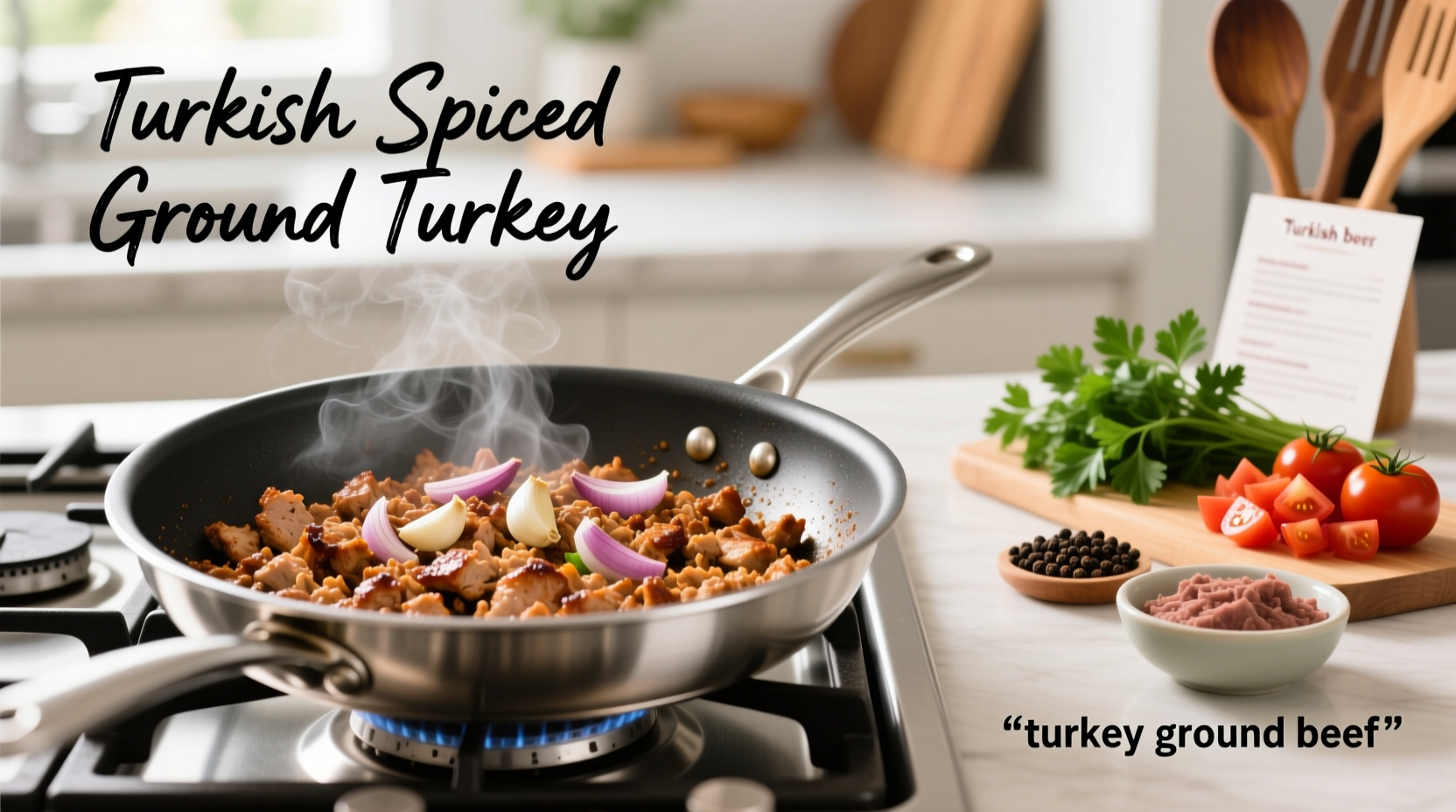Why Ground Turkey Demands Different Cooking Techniques
Understanding the science behind ground turkey preparation prevents disappointing results. With only 1-7% fat content compared to 15-30% in regular ground beef, turkey lacks the natural moisture that keeps beef burgers juicy. The USDA's Food Safety and Inspection Service confirms that poultry must reach 165°F internal temperature to eliminate harmful bacteria like Salmonella—a non-negotiable safety requirement that impacts cooking duration and technique.
| Protein Type | Average Fat Content | Calories (4oz) | Protein (4oz) | Safe Internal Temp |
|---|---|---|---|---|
| Regular Ground Beef | 15-30% | 290 | 22g | 160°F |
| Lean Ground Turkey | 1-7% | 200 | 22g | 165°F |
This nutritional comparison from the USDA FoodData Central explains why turkey requires different handling. The lower fat content means less margin for error during cooking—just 60 seconds past perfect doneness can transform moist turkey into dry crumbles.
Essential Equipment Checklist
Before starting, gather these kitchen essentials:
- Digital instant-read thermometer (critical for accuracy)
- Cast-iron or stainless steel skillet (avoid non-stick for better browning)
- Wooden spoon with flat edge (for proper scraping)
- Small bowl for pre-mixing seasonings
Step-by-Step Perfect Cooking Method
Preparation Phase: The 5-Minute Foundation
Proper preparation prevents 90% of common cooking failures. Remove turkey from packaging and pat thoroughly dry with paper towels—excess moisture creates steam instead of sear. For every pound of turkey, mix in:
- 1 tablespoon olive oil or melted butter
- 1 teaspoon Worcestershire sauce (adds umami depth)
- ½ teaspoon baking soda (raises pH for moisture retention)

Cooking Process: Temperature Control Secrets
Heat your skillet over medium-high heat for 2 full minutes until water droplets sizzle violently. Add 1 teaspoon neutral oil (avocado or canola), then the turkey. Do not press down—this squeezes out precious juices. Break into small, even pieces using your spoon's edge.
Cook undisturbed for 3 minutes to develop fond (those delicious browned bits), then stir every 90 seconds. The entire process should take 10-15 minutes. Insert your thermometer into the thickest cluster—never trust color alone as ground turkey often appears done at 150°F but remains unsafe.
Finishing Techniques for Maximum Flavor
Once reaching 165°F, immediately remove from heat. Stir in 1-2 tablespoons of acid (lemon juice or apple cider vinegar) to brighten flavors. Let rest 3 minutes—this allows juices to redistribute. For taco applications, add lime juice and cumin during the last minute of cooking to preserve volatile flavor compounds.
Flavor Enhancement Strategies That Work
Professional chefs use these science-backed methods to overcome turkey's mild flavor profile:
Moisture Retention Matrix
Understanding which ingredients combat dryness at different cooking stages:
- Pre-cooking: Baking soda (¼ tsp per pound) raises meat's pH, helping it retain 20% more moisture during cooking (per USDA Agricultural Research Service studies)
- During cooking: Deglaze with ¼ cup broth when fond develops to incorporate flavorful compounds
- Post-cooking: Acid additions (vinegar, citrus) reanimate flavors without adding moisture
Spice Pairing Principles
Ground turkey responds best to robust flavors. Create balanced profiles using this framework:
- Earthy base: Cumin, smoked paprika, garlic powder
- Acid component: Lemon zest, apple cider vinegar
- Umami boost: Worcestershire, tomato paste, soy sauce
- Finishing touch: Fresh herbs (parsley, cilantro) added off-heat
Recipe Variations for Real Kitchen Scenarios
Taco Tuesday Transformation
For authentic street-style tacos: Cook turkey with 1 tsp cumin and ½ tsp chipotle powder. During the last 2 minutes, add 2 tbsp masa harina dissolved in ¼ cup broth. This traditional technique (documented by the Smithsonian Food History Project) creates complex flavor while maintaining moisture.
Meatloaf Moisture Method
Combine 1 pound turkey with ⅓ cup soaked breadcrumbs, 1 egg, and 2 tbsp grated zucchini. The vegetable adds moisture without altering flavor. Bake at 375°F until thermometer reads 165°F (typically 45-55 minutes). Rest 10 minutes before slicing.
Troubleshooting Common Problems
Dryness Prevention Protocol
If your turkey consistently turns out dry, implement this corrective sequence:
- Verify thermometer accuracy using ice water (should read 32°F) and boiling water (212°F)
- Increase initial fat content: Use 93% lean turkey or add 1 tbsp olive oil per pound
- Reduce cooking temperature: Medium instead of medium-high
- Shorten cooking time: Check temperature at 8 minutes instead of 10
Sticking Solution
Turkey sticks more than beef due to lower fat content. Prevent this by:
- Heating skillet until water droplets dance (Leidenfrost effect)
- Adding oil that smokes slightly before adding meat
- Waiting full 3 minutes before first stir
Storage and Reheating Guidelines
Cool cooked turkey within 2 hours. Store in airtight containers with 1-2 tablespoons of cooking liquid or broth. Refrigerate up to 3 days or freeze up to 3 months. When reheating:
- Stovetop: Use medium-low heat with 1 tbsp broth, covered
- Micro: 30-second intervals at 50% power with damp paper towel
- Never reheat above 140°F to prevent further moisture loss











 浙公网安备
33010002000092号
浙公网安备
33010002000092号 浙B2-20120091-4
浙B2-20120091-4